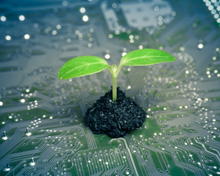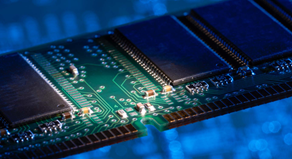What is Greening?
As time goes on, concern for the well-being of our planet has grown. Carbon emissions are one of the major topics people think about when discussing how to help the environment. According to IEA, there were 31.5 Gigatons of CO2 emissions in 2020 and 33.0 Gigatons in 2021 globally [1]. To put this into perspective, the average person produces 2.3 pounds [2] of CO2 per day which would be about 1.2710-11 % of the CO2 emissions in 2021. With this in mind, many people do not know that a small portion comes from computing and IT systems. So how does computing and software play a role in the environment? According to an article published by IEEE Software, IT systems were the cause of at least 2% of the global carbon dioxide emissions [3].
 One of the ways this can be solved is through more efficient hardware and software. The act of creating energy efficient software is called “Greening.” Greening aims to balance performance with how much energy is being consumed. As consumers, we usually desire the fastest computers and the high performance technology, but the odds are consumers will use more energy than what people would prefer. This puts software engineers in a difficult position. Eventually, the priority of green software will rise along with advancing technology.
One of the ways this can be solved is through more efficient hardware and software. The act of creating energy efficient software is called “Greening.” Greening aims to balance performance with how much energy is being consumed. As consumers, we usually desire the fastest computers and the high performance technology, but the odds are consumers will use more energy than what people would prefer. This puts software engineers in a difficult position. Eventually, the priority of green software will rise along with advancing technology.
Emissions by the technology sector are predicted to account for 14% globally of total emissions [4]. Something that would require large amounts of energy would be AI or machine learning. According to the Harvard Business Review with the iconic iris flower dataset, accuracy of 96.17% required 964 joules of energy. An increase in accuracy would lead to 3-4 times as much energy required to run this dataset. Now scaling these statistics to larger scale datasets and substantial runtimes, massive amounts of energy will be consumed.
Now that we have an idea of how much technology can take a toll on the environment, we can discuss how to make code development greener. Hamid Shojaee from Axosoft has five ways to make this happen [5]. I will go over the three that I think would anticipate to be most significant: faster code, memory management and redesigning inefficient code.
Faster code essentially comes down to making sure the hardware is not being used for longer than it needs to. Software does not directly have emissions, but the hardware does. Even when thinking about future technology and its advancements, it is not worth waiting for technology and processors to advance. Emissions are an issue right now and can be decreased before any new technology. Having fast and efficient code now will be even faster for when technology does advance.
Memory management ties into the idea that hardware is utilized by the software we create which together affect emissions. Keeping hardware in mind, a software engineer’s goal would be to use the least amount of memory possible. Shojaee mentions that higher memory would lead to part replacement and upgrades which he indirectly says is wasteful. Keeping the memory usage at a minimum could also help the hardware run more tasks at once ideally saving energy.
software we create which together affect emissions. Keeping hardware in mind, a software engineer’s goal would be to use the least amount of memory possible. Shojaee mentions that higher memory would lead to part replacement and upgrades which he indirectly says is wasteful. Keeping the memory usage at a minimum could also help the hardware run more tasks at once ideally saving energy.
Being a part of the software field means that we have to hold ourselves to a high standard and keep our code clean and efficient. Even if fixing bugs is time consuming, backtracking and making improvements will clear dozens of lines of code. I know this is not what people want to hear when it comes to revisiting our difficult code, but going back is a good practice that will only benefit the software and could even teach you a trick or two.
 Moving forward, companies need to start implementing these changes to help cutdown on emissions. Even with new infrastructure, precautions could be taken to make sure the hardware itself is not causing as much emissions as before. Companies have already started greening, but there are still considerably huge amounts that have not started. These changes do not have to be immediate or drastic. Greening can be a goal to work towards although hopefully to be achieved sooner than later.
Moving forward, companies need to start implementing these changes to help cutdown on emissions. Even with new infrastructure, precautions could be taken to make sure the hardware itself is not causing as much emissions as before. Companies have already started greening, but there are still considerably huge amounts that have not started. These changes do not have to be immediate or drastic. Greening can be a goal to work towards although hopefully to be achieved sooner than later.
Written by:
Alex Howell, GreenTech 2022 Social Media Manager
Follow Us / Tweet Us / Facebook Us / Contact Us
About IEEE GreenTech
The IEEE Green Technology Conference (GreenTech) was developed to address one of the most pressing challenges of our time: to produce green and clean energy in the 21st century to help conserve the environment. GreenTech’s main areas of interest include but are not limited to renewable energy and smart grids, energy generation, transmission, distribution and storage, transportation, electrification. The aim of GreenTech is to serve as a medium for professionals from academia, research centers, and industries worldwide to discuss and present the latest developments and applications related to the challenges of securing green and energy sources. This conference will highlight collaboration from professionals of various backgrounds to address the challenges of the production process, energy grid operations, and brainstorm solutions to build a reliable and sustainable power grid.
About the Houston Section
The Houston Section has been in existence for more than 90 years serving the greater metro Houston Area. We serve more than 4,000 higher grade members and over 300 student members living and working throughout the greater Metro Houston area. The Houston Section is one of 26 sections in Region 5 with 15 Society Chapters and Affinity Groups and 5 Student Branch Chapters. The Section provides planning and funding support to assure Chapters have vibrant programs to support members’ careers and meet the IEEE mission of Advancing Technology for Humanity. We hope your visit to the website will allow you to find ways to become more active in the greater Houston Area.
Join IEEE Today
Join a community of over 420,000 technology and engineering professionals united by a common desire to continuously learn, interact, collaborate, and innovate. Get the resources and opportunities you need to keep on top of changes in technology, get involved in standards development, network with other professionals in your local area or within a specific technical interest, and mentor the next generation of engineers and technologists.
[1] “CO2 emissions – Global Energy Review 2021 – analysis,” IEA. [Online]. Available: https://www.iea.org/reports/global-energy-review-2021/co2-emissions. [Accessed: 01-Dec-2021].
[2] B. Palmer, “Waiting to exhale,” NRDC, 19-May-2015. [Online]. Available: https://www.nrdc.org/onearth/waiting-exhale. [Accessed: 02-Dec-2021].
[3] A. B. Bener, M. Morisio and A. Miranskyy, “Green Software,” in IEEE Software, vol. 31, no. 3, pp. 36-39, May-June 2014, doi: 10.1109/MS.2014.62.
[4] S. Podder, A. Burden, S. Kumar Singh, and R. Maruca, “How green is your software?,” Harvard Business Review, 18-Sep-2020. [Online]. Available: https://hbr.org/2020/09/how-green-is-your-software. [Accessed: 02-Dec-2021].
[5] H. Shojaee, “Rules for being a Green Software Engineer: Dev blog by Axosoft,” Axosoft. [Online]. Available: https://www.axosoft.com/dev-blog/rules-for-being-a-green-software-engineer. [Accessed: 02-Dec-2021].
[6] Green software. [Online]. Available: https://www.adesso.ch/en/impulse/green-it/index.jsp. [Accessed: 09-Dec-2021].
[7] “10+ ways to free up Ram on your windows or mac device,” Panda Security Mediacenter, 03-Apr-2020. [Online]. Available: https://www.pandasecurity.com/en/mediacenter/tips/how-to-free-up-ram/. [Accessed: 08-Dec-2021].
[8] A. Greenwood, “4 examples of how to Nurture Innovation – Workstars,” Employee recognition and engagement blog. [Online]. Available: https://www.workstars.com/recognition-and-engagement-blog/2017/06/07/4-examples-nurture-innovation/. [Accessed: 08-Dec-2021].
